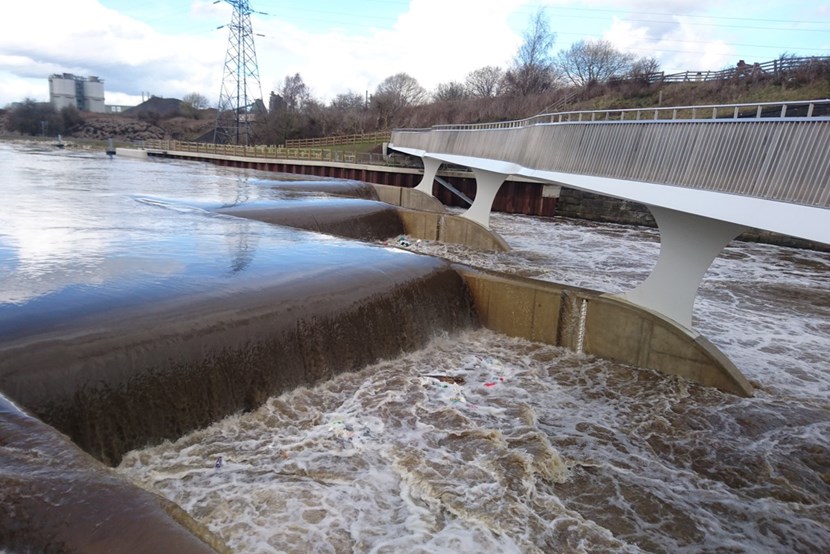
30 Oct 2023
Leeds flood defences perform as designed during Storm Babet
Leeds City Council has today issued an update on the current known impacts of Storm Babet, which brought high winds and heavy rain between October 19-21 2023.
Yellow and amber alerts for rainfall were issued by the Met Office across the storm. The high levels of rainfall resulted in a peak river level of 3.64m recorded at the Armley gauge on the river Aire. This is around 0.9m higher than the top of the typical range, but lower than levels recorded in previous events such as storm Ciara in 2020, or storms Dudley, Eunice, and Franklin in 2022.
Officers from a range of Leeds City Council services including flood risk management, resilience and emergencies and highways began working with partners from the Environment Agency to put plans into place as soon as the named storm was forecast. During the event, they worked in conjunction with emergency services including West Yorkshire Police and West Yorkshire Fire and Rescue Service as well as community groups, flood wardens and Network Rail to monitor and respond to help keep people safe.
Fortunately, this preparation and combined action resulted in just a small number of flooding impacts recorded across the storm, all of which are being responded to by the council’s flooding investigations team.
On the afternoon of October 20, river levels on the Aire triggered the need for the Leeds Flood Alleviation Scheme (FAS) to be activated. The moveable weirs at Crown Point and Knostrop were lowered to allow more room in the channel, successfully defending the city centre from flooding. In the image below, you can see a graph depicting the impact that operating the Leeds FAS had on river levels recorded at the Knostrop weir gauge, temporarily lowering the levels to prevent them reaching the point where flooding would be possible, then gradually raising back up again once the peak had safely passed.
This is the 9th time that the £50million scheme has been operated since its completion in 2017.
The Leeds Flood Alleviation Scheme phase 2 is under construction and will not provide the full level of protection until it is complete in spring 2024. Despite the full benefits of the scheme not yet being realised, there were some examples of the scheme already proving effective in certain areas, for example, the newly installed flood walls effectively protecting the Kirkstall Bridge Inn as designed.
As construction of flood defences are ongoing, there are many building sites near the river, and in areas that are prone to flooding. In the run up to the storm site operatives from our contractor partners successfully ensured that equipment and materials were moved or secured safely, including a pontoon being secured to the riverbed, following risk assessments, and fully considering the detailed forecast from the Environment Agency.
Despite this, there has been some impact to a small number of building sites. Council officers and our construction partners are already working diligently to resume work on the scheme, which will protect a further 1,048 homes and 474 businesses as well as doubling the standard of protection for the city centre.
Councillor Helen Hayden, Leeds City Council’s executive member for sustainable development and infrastructure, said:
“Our sympathies go out to those who were impacted by Storm Babet across the United Kingdom. Whilst we are fortunate that Leeds did not feel the effects as fiercely as other areas, some of us across the city did experience flooding, and we are working with communities to support them in their recovery.
"In Leeds, we have invested significantly in flood alleviation schemes to ensure that weather events at this level, and much worse, can be handled with minimum impact on our infrastructure, businesses, and communities. This is the third significant weather event to hit our region in the last five years, and further evidence that interventions like the Leeds Flood Alleviation Scheme are necessary to ensure that we are resilient to the climate emergency now and in the future.
“Thank you to everyone who worked diligently over the weekend to keep us all safe, and to those who are continuing to improve our resilience to severe weather across Leeds. There is a huge amount of time that people give up when it comes to flood management, often on short notice and unsociable hours, that the public never see. That work is so important, and I would really like to stress my personal thanks to all involved”
Flooding affects many in our communities, and there are actions that we can all take to prepare and to keep ourselves safe:
- Do not attempt to travel through flood water, on foot, in a vehicle or otherwise.
- Create a flood plan for your home or business using the template from the Environment Agency
- Sign up for flood alerts in your area for free on gov.uk
- Read guidance on the different types of flood warnings, and what they mean for your home or your travel plans
For media enquiries contact:
Leeds City Council Communications team
communicationsteam@leeds.gov.uk
